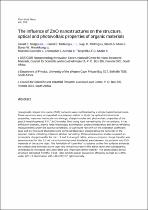 ResearchSpace
ResearchSpace
The influence of ZnO nanostructures on the structure, optical and photovoltaic properties of organic materials
JavaScript is disabled for your browser. Some features of this site may not work without it.
- ResearchSpace
- →
- Research Publications/Outputs
- →
- Journal Articles
- →
- View Item
| dc.contributor.author |
Malgas, GF

|
|
| dc.contributor.author |
Motaung, DE

|
|
| dc.contributor.author |
Mhlongo, Gugu H

|
|
| dc.contributor.author |
Nkosi, SS

|
|
| dc.contributor.author |
Mwakikunga, Bonex W

|
|
| dc.contributor.author |
Govendor, M

|
|
| dc.contributor.author |
Arendse, CJ

|
|
| dc.contributor.author |
Muller, TFG

|
|
| dc.date.accessioned | 2014-07-30T09:11:08Z | |
| dc.date.available | 2014-07-30T09:11:08Z | |
| dc.date.issued | 2014-03 | |
| dc.identifier.citation | Malgas, G.F, Motaung, D.E, Mhlongo, G.H, Nkosi, S.S, Mwakikunga, B.W, Govendor, M, Arendse, C.J and Muller, T.F.G. 2014. The influence of ZnO nanostructures on the structure, optical and photovoltaic properties of organic materials. Thin Solid Films, vol. 555, pp 100-106 | en_US |
| dc.identifier.issn | 0040-6090 | |
| dc.identifier.uri | http://ac.els-cdn.com/S0040609013013047/1-s2.0-S0040609013013047-main.pdf?_tid=c4f68e8c-171d-11e4-b769-00000aab0f6b&acdnat=1406637915_97fee9734fed3d7e8cf3709453593e25 | |
| dc.identifier.uri | http://hdl.handle.net/10204/7526 | |
| dc.identifier.uri | https://doi.org/10.1016/j.tsf.2013.08.012 | |
| dc.identifier.uri | https://www.sciencedirect.com/science/article/pii/S0040609013013047 | |
| dc.description | Copyright: 2014 Elsevier. This is an ABSTRACT ONLY. The definitive version is published in Thin Solid Films, vol. 555, pp 100-106 | en_US |
| dc.description.abstract | Hexagonally shaped zinc-oxide (ZnO) nanorods were synthesized by a simple hydrothermal route. These nanorods were incorporated in a polymer matrix to study the optical and structural properties, improved nanoscale morphology, charge transfer and photovoltaic properties of the poly(3-hexylthiophene) P3HT:ZnO blended films using light harvesting by UV–vis analysis, X-ray diffraction analysis, atomic force microscopy examination, photoluminescence and device efficiency measurements under the optimal conditions. A significant red-shift on the extinction coefficient peak and an improved absorptionwere demonstrated upon incorporating the nanorods in the polymer matrix indicating enhanced photon harvesting. Photoluminescence studies revealed an incomplete charge transfer for the 1:2 and 1:4 weight ratios, while a complete charge transfer was demonstrated for the 1:1 wt. ratio due to improved interfacial area between the polymer and ZnO materials in the active layer. The formation of “cone-like” structures on the film surfaces enhances the contact area between active layer and metal electrode in the active layer and subsequently, contributes to increased light absorption and improved carrier mobility. The photovoltaic device structure fabricated fromthe 1:1wt. ratio exhibits power conversion efficiency as high as 1.40% under AM 1.5 illumination with 100 mW/cm(sup2) light intensity. | en_US |
| dc.language.iso | en | en_US |
| dc.publisher | Elsevier | en_US |
| dc.relation.ispartofseries | Workflow;12139 | |
| dc.subject | Poly(3-hexylthiophene) | en_US |
| dc.subject | ZnO nanorods | en_US |
| dc.subject | Photovoltaic properties | en_US |
| dc.subject | Hexagonally shaped zinc-oxide | en_US |
| dc.subject | P3HT:ZnO | en_US |
| dc.subject | UV–vis analysis | en_US |
| dc.title | The influence of ZnO nanostructures on the structure, optical and photovoltaic properties of organic materials | en_US |
| dc.type | Article | en_US |
| dc.identifier.apacitation | Malgas, G., Motaung, D., Mhlongo, G. H., Nkosi, S., Mwakikunga, B. W., Govendor, M., ... Muller, T. (2014). The influence of ZnO nanostructures on the structure, optical and photovoltaic properties of organic materials. http://hdl.handle.net/10204/7526 | en_ZA |
| dc.identifier.chicagocitation | Malgas, GF, DE Motaung, Gugu H Mhlongo, SS Nkosi, Bonex W Mwakikunga, M Govendor, CJ Arendse, and TFG Muller "The influence of ZnO nanostructures on the structure, optical and photovoltaic properties of organic materials." (2014) http://hdl.handle.net/10204/7526 | en_ZA |
| dc.identifier.vancouvercitation | Malgas G, Motaung D, Mhlongo GH, Nkosi S, Mwakikunga BW, Govendor M, et al. The influence of ZnO nanostructures on the structure, optical and photovoltaic properties of organic materials. 2014; http://hdl.handle.net/10204/7526. | en_ZA |
| dc.identifier.ris | TY - Article AU - Malgas, GF AU - Motaung, DE AU - Mhlongo, Gugu H AU - Nkosi, SS AU - Mwakikunga, Bonex W AU - Govendor, M AU - Arendse, CJ AU - Muller, TFG AB - Hexagonally shaped zinc-oxide (ZnO) nanorods were synthesized by a simple hydrothermal route. These nanorods were incorporated in a polymer matrix to study the optical and structural properties, improved nanoscale morphology, charge transfer and photovoltaic properties of the poly(3-hexylthiophene) P3HT:ZnO blended films using light harvesting by UV–vis analysis, X-ray diffraction analysis, atomic force microscopy examination, photoluminescence and device efficiency measurements under the optimal conditions. A significant red-shift on the extinction coefficient peak and an improved absorptionwere demonstrated upon incorporating the nanorods in the polymer matrix indicating enhanced photon harvesting. Photoluminescence studies revealed an incomplete charge transfer for the 1:2 and 1:4 weight ratios, while a complete charge transfer was demonstrated for the 1:1 wt. ratio due to improved interfacial area between the polymer and ZnO materials in the active layer. The formation of “cone-like” structures on the film surfaces enhances the contact area between active layer and metal electrode in the active layer and subsequently, contributes to increased light absorption and improved carrier mobility. The photovoltaic device structure fabricated fromthe 1:1wt. ratio exhibits power conversion efficiency as high as 1.40% under AM 1.5 illumination with 100 mW/cm(sup2) light intensity. DA - 2014-03 DB - ResearchSpace DP - CSIR KW - Poly(3-hexylthiophene) KW - ZnO nanorods KW - Photovoltaic properties KW - Hexagonally shaped zinc-oxide KW - P3HT:ZnO KW - UV–vis analysis LK - https://researchspace.csir.co.za PY - 2014 SM - 0040-6090 T1 - The influence of ZnO nanostructures on the structure, optical and photovoltaic properties of organic materials TI - The influence of ZnO nanostructures on the structure, optical and photovoltaic properties of organic materials UR - http://hdl.handle.net/10204/7526 ER - | en_ZA |





